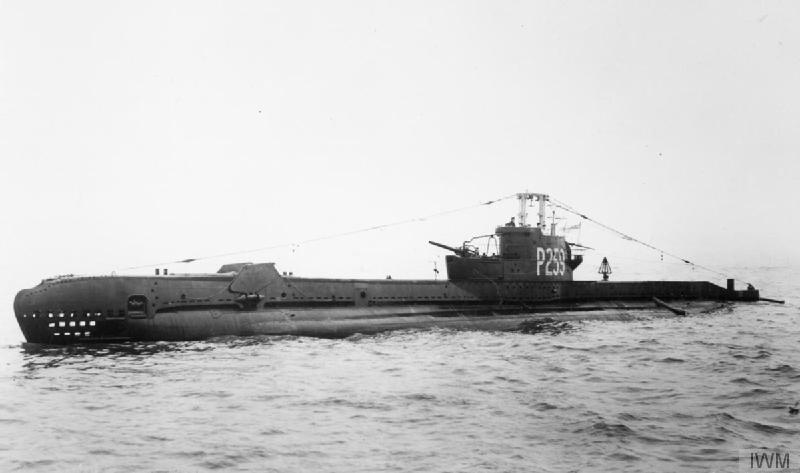S-Class Submarine

Battle Honours
Crimea 1854-55
Atlantic 1945
Specifications
Builder: Cammell Laird Shipyard, Birkenhead, United Kingdom
Displacement: 814 tons
Length: 217 ft
Beam: 23 ft 8 in
Draught: 11 ft
Propulsion: 2 × 950 bhp (708 kW) diesel engines, 2 × 650 hp (485 kW) electric motors driving two propellers
Speed: 14.75 knots (16.97 mph; 27.32 km/h) surfaced. 9 knots (10 mph; 17 km/h) submerged
Range: 7,500 Nautical miles surfaced (8,600 mi; 13,900 km) at 10 knots (12 mph; 19 km/h) 120 Nautical miles submerged ( 140 mi; 220 km) at 3 knots (3.5 mph; 5.6 km/h)
Armament: 6 × bow & 1 stern 21 in (533 mm) torpedo tubes – carried 13 torpedoes or 12 mines; 1 × three-inch (76 mm) gun (QF 4-inch deck gun; 1 × 20 mm Oerlikon AA gun; 3 × .303 calibre machine guns
Crew complement: 48
Commanding Officers
Lt. Henry Carty Gowan, RN Oct 1944 - 27 Dec 1945
Post War:
Lt. P.A. Fickling, July 1950 - Feb 1952
Lt. P.H. Harper, Apr 1955
Lt. Cdr H.T. Verry, RN August 1854
Related items
None
Reminiscences
None
Gallery
None
H.M. S/M SIDON
PAGE UNDER CONSTRUCTION
Read aloud

Image copyright IWM (FL 3632)
History
P259 was ordered from Cammell Laird Shipbuilders, Birkenhead, on November 17th 1942, one of the batch four boats ordered as part the third group of S class submarines for the Royal Navy. Her keel was laid down on July 7th 1943. She was launched on September 4th 1944.
On completion of her builder’s trials P259 departed for Holy Loch on November 21st 1944, arriving the following day. While at Holy Loch she was to conduct Torpedo, Gunnery, Bombardment, D/F and RDF exercises and performed simulated day and night attacks, both submerged and surface actions. She would also undergo trials at the torpedo firing range at Arrochar, and full speed trials on the Arran measured mile..
She commissioned as H.M. Submarine SIDON at Holy Loch on November 23rd 1944 under the command of Lieutenant H.C. Gowan, RN.
Reallocated to the British Pacific Fleet
H.M. Submarine SIDON departed the Clyde for Gibraltar on April 7th 1945 with convoy OS 121 / KMS 95 for the passage to Gibraltar on the first leg of the trip to the Far East where she was to join the 8th Submarine Flotilla based at Subic Bay.
By the time she had reached Trincomalee, Ceylon she was experiencing battery problems; it had been intended that she sail directly from Ceylon to Subic bay but her repairs could not be undertaken locally or in the Philippines. She was routed to Fremantle to receive her repairs departing Trincomalee on June 1st. The work was not competed until early July, she sailed for Subic Bay on the 7th and arrived on station on August 3rd1945.
Post War history
After the war had ended SIDON went to Hong Kong before she returned to the UK in late 1945 and was decommissioned into reserve on 27 December 1945.
After the war the surviving S Class boats were refitted to install a folding snorkel mast aft of the control tower; to accommodate this the stern torpedo tube and the 'Bandstand' Anti-Aircraft platform and 20mm Oerlikon were removed. Some had their main deck gun removed as well. The snorkel allowed a submarine to cruise on diesel engines while submerged allowing the batteries to be recharged without the need to surface and risk detection by an enemy. When raised the ‘snort’ was the only part of the boat above the surface drawing in clean air while discharging the toxic diesel exhaust. Later modernisation work included installation of an improved sonar mounted in a dome on the casing above the forward dive plane and improved radar.
SIDON returned to Active duty in August 1954 under the command of Lieutenant Commander H.T. Verry, RN. She was employed during the live testing phase of the new Mk12 “Fancy” torpedo at Portland. On June 16th 1955, while moored alongside her depot ship HMS MAIDSTONE, she loaded two Mark 12 torpedoes for a test firing planned for later that day. The torpedoes had no warheads, but were powered by the highly volatile hydrogen peroxide propellant. SIDON had 56 men onboard at this time, her crew, plus trainees and trials personnel embarked for the trip. Shortly after securing the torpedoes the one in her No. 3 torpedo tube exploded. While attempts where being made to rescue those below decks the submarine sank without warning by the bows; Three officers and ten ratings lost their lives but the remainder were saved. SIDON was raised one week later on June 23rd and beached the next day. The 13 bodies were recovered two days later. A second spontaneous explosion of a “Fancy” torpedo at Arrochar torpedo range caused the project to be cancelled.
The wreck of the SIDON lies a few miles West of Portland intact and upright , she was briefly used as A/S target in June 1957
Last modified: 23 February 2023
Primary information sources
Additional sources:
uboat.net entry for H.M. Submarine SIDON
Comments (0)